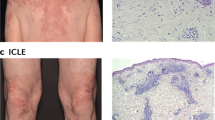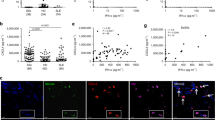Abstract
Inappropriate activation of innate immune mechanisms, in particular of the type I interferon (IFN) system, is regarded to play an important role in the pathogenesis of lupus erythematosus (LE). Type I IFN serum levels have been shown to correlate with the disease activity in systemic LE and additionally play a proinflammatory role in the development of LE skin lesions. Recent studies demonstrated a close morphological association between the expression pattern of IFN-inducible chemokines (MxA, CXCL10) and typical histological features of cutaneous LE. These and other studies suggest that a complex network of IFN-associated cytokines, chemokines and adhesion molecules orchestrates and promotes tissue injury observed in LE skin.
Similar content being viewed by others
References
Adam C, Thoua Y, Ronco P et al (1980) The effect of exogenous interferon: acceleration of autoimmune and renal diseases in (NZB/W) F1 mice. Clin Exp Immunol 40:373–382
Arrue I, Saiz A, Ortiz-Romero PL et al (2007) Lupus-like reaction to interferon at the injection site: report of five cases. J Cutan Pathol 34(Suppl 1):18–21. doi:10.1111/j.1600-0560.2007.00715.x
Asselin-Paturel C, Brizard G, Chemin K et al (2005) Type I interferon dependence of plasmacytoid dendritic cell activation and migration. J Exp Med 201:1157–1167. doi:10.1084/jem.20041930
Baechler EC, Batliwalla FM, Karypis G et al (2003) Interferon-inducible gene expression signature in peripheral blood cells of patients with severe lupus. Proc Natl Acad Sci USA 100:2610–2615. doi:10.1073/pnas.0337679100
Bennett L, Palucka AK, Arce E et al (2003) Interferon and granulopoiesis signatures in systemic lupus erythematosus blood. J Exp Med 197:711–723. doi:10.1084/jem.20021553
Blomberg S, Eloranta ML, Cederblad B et al (2001) Presence of cutaneous interferon-alpha producing cells in patients with systemic lupus erythematosus. Lupus 10:484–490. doi:10.1191/096120301678416042
Braun D, Geraldes P, Demengeot J (2003) Type I Interferon controls the onset and severity of autoimmune manifestations in lpr mice. J Autoimmun 20:15–25. doi:10.1016/S0896-8411(02)00109-9
Clark-Lewis I, Mattioli I, Gong JH et al (2003) Structure–function relationship between the human chemokine receptor CXCR3 and its ligands. J Biol Chem 278:289–295. doi:10.1074/jbc.M209470200
Costedoat-Chalumeau N, Amoura Z, Hulot JS et al (2006) Low blood concentration of hydroxychloroquine is a marker for and predictor of disease exacerbations in patients with systemic lupus erythematosus. Arthritis Rheum 54:3284–3290. doi:10.1002/art.22156
Dall’era MC, Cardarelli PM, Preston BT et al (2005) Type I interferon correlates with serological and clinical manifestations of SLE. Ann Rheum Dis 64:1692–1697. doi:10.1136/ard.2004.033753
Fah J, Pavlovic J, Burg G (1995) Expression of MxA protein in inflammatory dermatoses. J Histochem Cytochem 43:47–52
Farkas L, Beiske K, Lund-Johansen F et al (2001) Plasmacytoid dendritic cells (natural interferon-alpha/beta-producing cells) accumulate in cutaneous lupus erythematosus lesions. Am J Pathol 159:237–243
Graham RR, Kozyrev SV, Baechler EC et al (2006) A common haplotype of interferon regulatory factor 5 (IRF5) regulates splicing and expression and is associated with increased risk of systemic lupus erythematosus. Nat Genet 38:550–555. doi:10.1038/ng1782
Guillot B, Portales P, Du Thanh A et al (2005) The expression of cytotoxic mediators is altered in mononuclear cells of patients with melanoma and increased by interferon-alpha treatment. Br J Dermatol 152:690–696. doi:10.1111/j.1365-2133.2005.06512.x
Hasegawa K, Hayashi T (2003) Synthetic CpG oligodeoxynucleotides accelerate the development of lupus nephritis during preactive phase in NZB x NZWF1 mice. Lupus 12:838–845. doi:10.1191/0961203303lu483oa
Hooks JJ, Moutsopoulos HM, Geis SA et al (1979) Immune interferon in the circulation of patients with autoimmune disease. N Engl J Med 301:5–8
Iijima W, Ohtani H, Nakayama T et al (2003) Infiltrating CD8+ T cells in oral lichen planus predominantly express CCR5 and CXCR3 and carry respective chemokine ligands RANTES/CCL5 and IP-10/CXCL10 in their cytolytic granules: a potential self-recruiting mechanism. Am J Pathol 163:261–268
Kuhn A, Herrmann M, Kleber S et al (2006) Accumulation of apoptotic cells in the epidermis of patients with cutaneous lupus erythematosus after ultraviolet irradiation. Arthritis Rheum 54:939–950. doi:10.1002/art.21658
Kuhn A, Sonntag M, Lehmann P et al (2002) Characterization of the inflammatory infiltrate and expression of endothelial cell adhesion molecules in lupus erythematosus tumidus. Arch Dermatol Res 294:6–13. doi:10.1007/s00403-001-0286-7
Kuhn A, Sonntag M, Sunderkotter C et al (2002) Upregulation of epidermal surface molecule expression in primary and ultraviolet-induced lesions of lupus erythematosus tumidus. Br J Dermatol 146:801–809. doi:10.1046/j.1365-2133.2002.04693.x
Lovgren T, Eloranta ML, Bave U et al (2004) Induction of interferon-alpha production in plasmacytoid dendritic cells by immune complexes containing nucleic acid released by necrotic or late apoptotic cells and lupus IgG. Arthritis Rheum 50:1861–1872. doi:10.1002/art.20254
Lovgren T, Eloranta ML, Kastner B et al (2006) Induction of interferon-alpha by immune complexes or liposomes containing systemic lupus erythematosus autoantigen- and Sjogren’s syndrome autoantigen-associated RNA. Arthritis Rheum 54:1917–1927. doi:10.1002/art.21893
Meller S, Winterberg F, Gilliet M et al (2005) Ultraviolet radiation-induced injury, chemokines, and leukocyte recruitment: an amplification cycle triggering cutaneous lupus erythematosus. Arthritis Rheum 52:1504–1516. doi:10.1002/art.21034
Munoz LE, Gaipl US, Franz S et al (2005) SLE—a disease of clearance deficiency? Rheumatology (Oxford) 44:1101–1107. doi:10.1093/rheumatology/keh693
Nyberg F, Hasan T, Skoglund C et al (1999) Early events in ultraviolet light-induced skin lesions in lupus erythematosus: expression patterns of adhesion molecules ICAM-1, VCAM-1 and E-selectin. Acta Derm Venereol 79:431–436. doi:10.1080/000155599750009852
Nyberg F, Stephansson E (1999) Elevated soluble E-selectin in cutaneous lupus erythematosus. Adv Exp Med Biol 455:153–159
Rahman A, Isenberg DA (2008) Systemic lupus erythematosus. N Engl J Med 358:929–939. doi:10.1056/NEJMra071297
Ronnblom L, Eloranta ML, Alm GV (2006) The type I interferon system in systemic lupus erythematosus. Arthritis Rheum 54:408–420. doi:10.1002/art.21571
Santiago-Raber ML, Baccala R, Haraldsson KM et al (2003) Type-I interferon receptor deficiency reduces lupus-like disease in NZB mice. J Exp Med 197:777–788. doi:10.1084/jem.20021996
Smit MJ, Verdijk P, van der Raaij-Helmer EM et al (2003) CXCR3-mediated chemotaxis of human T cells is regulated by a Gi- and phospholipase C-dependent pathway and not via activation of MEK/p44/p42 MAPK nor Akt/PI-3 kinase. Blood 102:1959–1965. doi:10.1182/blood-2002-12-3945
Sontheimer RD, Thomas JR, Gilliam JN (1979) Subacute cutaneous lupus erythematosus: a cutaneous marker for a distinct lupus erythematosus subset. Arch Dermatol 115:1409–1415. doi:10.1001/archderm.115.12.1409
Tebbe B, Mazur L, Stadler R et al (1995) Immunohistochemical analysis of chronic discoid and subacute cutaneous lupus erythematosus—relation to immunopathological mechanisms. Br J Dermatol 132:25–31. doi:10.1111/j.1365-2133.1995.tb08620.x
Wenzel J, Henze S, Brahler S et al (2005) The expression of human leukocyte antigen-DR and CD25 on circulating T cells in cutaneous lupus erythematosus and correlation with disease activity. Exp Dermatol 14:454–459. doi:10.1111/j.0906-6705.2005.00301.x
Wenzel J, Henze S, Wörrenkämper E et al (2005) Role of the chemokine receptor CCR4 and its ligand TARC/CCL17 for lymphocyte recruitment in cutaneous lupus erythematosus. J Invest Dermatol 124:1241–1248. doi:10.1111/j.0022-202X.2005.23755.x
Wenzel J, Tuting T (2008) An IFN-associated cytotoxic cellular immune response against viral, self-, or tumor antigens is a common pathogenetic feature in “interface dermatitis”. J Invest Dermatol (in press), 17 April 2008 [Epub ahead of print]
Wenzel J, Tuting T (2007) Identification of type I interferon-associated inflammation in the pathogenesis of cutaneous lupus erythematosus opens up options for novel therapeutic approaches. Exp Dermatol 16:454–463. doi:10.1111/j.1600-0625.2007.00556.x
Wenzel J, Uerlich M, Worrenkamper E et al (2005) Scarring skin lesions of discoid lupus erythematosus are characterized by high numbers of skin-homing cytotoxic lymphocytes associated with strong expression of the type I interferon-induced protein MxA. Br J Dermatol 153:1011–1015. doi:10.1111/j.1365-2133.2005.06784.x
Wenzel J, Worenkamper E, Freutel S et al (2005) Enhanced type I interferon signalling promotes Th1-biased inflammation in cutaneous lupus erythematosus. J Pathol 205:435–442. doi:10.1002/path.1721
Wenzel J, Zahn S, Mikus S et al (2007) The expression pattern of interferon-inducible proteins reflects the characteristic histological distribution of infiltrating immune cells in different cutaneous lupus erythematosus subsets. Br J Dermatol 157:752–757. doi:10.1111/j.1365-2133.2007.08137.x
Conflict of interest statement
The authors have no potential conflict of interest.
Author information
Authors and Affiliations
Corresponding author
Rights and permissions
About this article
Cite this article
Wenzel, J., Zahn, S., Bieber, T. et al. Type I interferon-associated cytotoxic inflammation in cutaneous lupus erythematosus. Arch Dermatol Res 301, 83–86 (2009). https://doi.org/10.1007/s00403-008-0892-8
Received:
Accepted:
Published:
Issue Date:
DOI: https://doi.org/10.1007/s00403-008-0892-8




